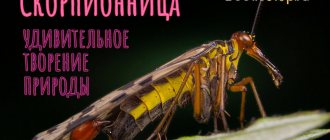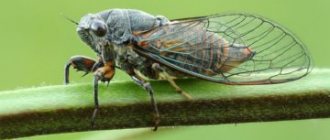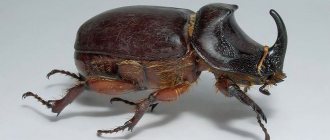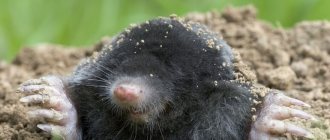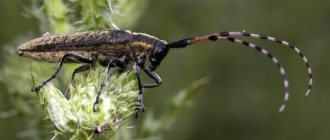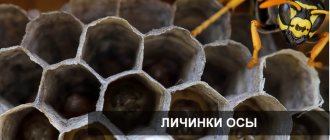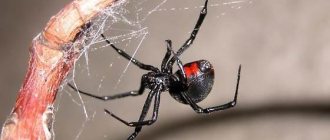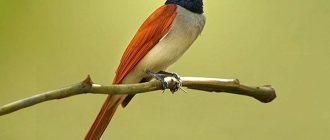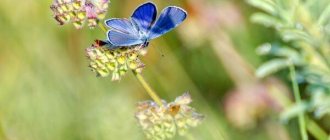Many people suffer from fruit flies. Their presence is very annoying, although insects are not carriers of serious diseases and do not damage furniture or food. The fruit fly loves to feed on uneaten pieces of food. As soon as you leave them somewhere, a whole flock immediately gathers. Therefore, some people want to get rid of insects faster, since they have no place in their home.
What is the external structure and color
The fruit fly Drosophila does not exceed 3 mm in length. On the head there are eyes that are red in color. Chitinous bristles and plates are involved in flight. The head is spherical in shape. Since flies can be classified as members of the order Diptera, their front pairs of wings are membranous.
The color of the body is yellow-brown, with black stripes. If you compare a fly by gender, differences will be noticeable. Namely:
- males are smaller than females;
- males have a completely black tip of the abdomen, so you can easily determine the sex with a magnifying glass;
- in females, the abdomen is made in the shape of a circle, and the end is pointed, and males have a cylinder, and the end is blunt;
- males have a genital comb on the forelimbs.
Origin of the species and description
Photo: Drosophila fly
The Drosophila fly can appear in any home, and in vegetable or fruit warehouses and stores it is a permanent resident. This animal is familiar to any gardener and gardener. This fly is quite annoying and extremely difficult to get rid of. Despite this, fruit flies are highly valued by scientists. They are unique scientific material. Today various experiments and scientific experiments are carried out on this animal.
Video: Drosophila fly
The Drosophila fly is called differently: Drosophila minor, fruit fly, fruit midge, Drosophila vulgaris. In Latin the name sounds like Drosophila melanogaster. This is an insect with two wings, a type of midge belonging to the genus Drosophila. Drosophila belongs to a large family of fruit flies.
Interesting fact: Drosophila has many different names and nicknames. People call these insects wine or vinegar flies. This is due to the fact that they very quickly detect the source of the sour fruity smell. Therefore, there are many such animals in various factories and plants for the production of juices and wine.
Today there are quite a few varieties of fruit flies. Scientists count more than a thousand species. Most species live in subtropical and tropical climates. In particular, more than three hundred species of such insects live on the Hawaiian Islands alone. On the territory of the Russian Federation, the most common type of fly is the flightless Drosophila.
The Drosophila fly is characterized by the following features:
- a diet consisting of fermented products;
- high sensitivity to sour aromas;
- fertility - one female is capable of laying several hundred eggs throughout her life;
- the presence of obvious visual differences between females and males.
What are the features of the life cycle
If conditions are favorable, the larva emerges from the egg one day after the female lays eggs. They grow in 5 days, molting occurs twice - one day after hatching and 48 hours later. Eggs and larvae can exist in a semi-liquid sphere because the fly lays them in rotten fruit.
First, the larvae swim on the surface, and before pupation they descend into the depths. During the active period of life they feed on fruit substances. After 5 days, the larva turns into a pupa. After another 5 days, an adult appears.
How long do they live?
To understand how long fruit flies live, it is necessary to study their life cycle. The adult often lays eggs in rotting fruit.
At an average ambient temperature of +25 degrees, within 10 days the eggs reach the adult stage. At temperatures below +18 degrees, the development of the larvae slows down by 2 times.
The average life cycle of Drosophila is 1 – 2 months. Life expectancy depends on external factors (environmental conditions). At high temperatures, the lifespan of a fly can be less than 1 month.
During their existence, females produce an average of 400 clutches of eggs measuring 0.5 mm. Under unfavorable environmental conditions, the number of eggs is significantly less. However, the shorter the life cycle of flies, the more offspring they try to produce.
What are the features of the genome
Flies are interesting for science. Their somatic cells contain 8 chromosomes. Because of this mutation there is great diversity. Flies are the most studied species in the world. The insect is widely used in genetics to look at the effects of different drugs.
Read on topic:
Causes and methods of eliminating anthractosis
14.11.2020
Why do signs of blossom end rot appear on tomatoes?
14.11.2020
Signs of verticillium and ways to eliminate the fungus
14.11.2020
Methods for catching ferrets on the site
20.06.2019
Scientists have proven that when a fly is exposed to human viruses, in 61% of cases the reaction is the same as in humans.
Behavioral genetics
Molecular biologist Seymour Benzer and his colleague Ron Konopka published a joint work, “The Drosophila Mutant Clock,” in the 1970s. In their work, scientists described a mutation in the first hours of life, which affected the behavior of the insect.
Unlike animals, the rhythm of life of fruit flies was very different. They could actively move or rest at any time interval. The research was carried out over 28 years. Over such a long period, biologists have proven that the mutation affects genes responsible for molecular and biochemical clocks. “Clock” cells that influence the activity of the pest are located in the central brain of the insect.
Where does the pest come from?
Eggs are laid on food. Laying is not uncommon in summer, as the eggs are resistant to all temperature changes. Doubling in number occurs at a high speed, so if you do not take methods to get rid of them, there will be a huge number of insects in the apartment. A pest may appear in an apartment due to the following reasons:
- together with vegetables and fruits, for example, a person bought them in a supermarket or harvested their own crops, and the larvae have already penetrated the food;
- the windows in the house are often open, and there are no mosquito nets on them;
- penetration along with soil that was taken from the street;
- entered the house together with pets who periodically walk outside.
The flies are so small that it is difficult to notice them on an animal or food.
Under certain conditions, the number of Drosophila flies increases rapidly. Namely:
- Lack of indoor cleaning.
- Dirty dishes. For example, if a person does not wash it right away and leaves it for a long time.
- Presence of old tea leaves in the teapot.
- Unfinished liquids – juice, carbonated drinks.
- Insufficient care of house plants. For example, if a person constantly waters a flower, and it already contains a large amount of moisture.
- Place tea leaves in a pot. Some people use this method for feeding. Subsequently, decay occurs and this leads to the appearance of pests.
- Leftover food.
- Storing food in non-refrigerated conditions.
- A full trash can left for a long time.
Drosophila fly nutrition
These types of flies feed on a variety of vegetables and fruits, suck sap from trees, but their favorite delicacy is spoiled fruit. But it all depends on the type of fly.
For example, fruit flies do not have a strictly specialized structure of the oral apparatus, so they can consume free liquids of various origins:
- plant juice;
- sugary liquid;
- decomposing tissues of both plant and animal origin;
- discharge from the eyes, wounds, armpits of various animals;
- animal urine and feces.
Therefore, to avoid the appearance of this type of flies in your home, you need to carefully monitor cleanliness, especially if there are pets in your home.
What are some interesting facts related to insects?
There are many facts about the Drosophila fly. Namely:
- The eye contains small optical units, about 760 of them. 1 is called ommadia. It contains 8 receptors that react to light. For example, when the light is bright, they extinguish it, and when it is weak, they intensify it. Due to this property, the fly sees perfectly in any weather conditions. Compared to other insects, the Drosophila's vision is considered the most developed.
- During a flight, a fly can make up to 220 wing beats. This figure is the highest compared to other insects. However, the fly cannot be heard due to the special shape of the wings.
- Insects are not harmful to humans.
Content
- 1 Etymology
- 2 Morphology
- 3 Life cycle and ecology 3.1 Habitat
- 3.2 Reproduction
- 3.3 Mating systems 3.3.1 Courtship behavior
- 3.3.2 Polyandry
- 3.3.3 Sperm competition
genome project species
What harm does an insect cause?
Flies are not dangerous to humans. But when they appear, people begin to get nervous. Although fruit flies do not suffer any serious diseases, they do not bite. The maximum possible harm from their presence is gastrointestinal upset. But the constant presence of flies in the field of view is annoying. They can eat fruits and vegetables in the house, making food unappealing. They also crawl on plates and throughout the living area.
It is not difficult to remove fruit flies, but it must be done on time.
Species of Drosophila fly
Today, there are 1,529 species of flies from the Drosophila family. Some of them are presented below.
1. Drosophila black. It is the most studied of the entire family of these flies. It has a yellow or brown color. The eyes are bright red. Body sizes range from 2 to 3 millimeters.
The larvae of the Drosophila fly of this species are white, but as they grow, they change their color. Females have dark stripes on their bellies, while males have one dark spot. During her life, the female is able to lay about 300 eggs.
In the photo there is a black Drosophila
2. Drosophila fruit. They feed mainly on juice from fruit plants; the larvae eat microorganisms. The dimensions of the chest vary from 2.5 to 3.5 millimeters. The wingspan is 5–6 millimeters. The central part of the back is yellowish-brown in color, the belly is yellow with brown spots, the chest is brownish-yellow or completely yellow.
The eyes are bright red. Males of this species have a small black spot at the bottom of their wings. The development of an individual occurs in the period from 9 to 27 days; during one season of the year, about 13 generations grow. Females of this species are much larger than males.
In the photo, Drosophila fruit fly
3. Drosophila does not fly. Among other individuals, they are distinguished by their inability to fly, since they have underdeveloped wings and are able to move by crawling or jumping. This species was not obtained naturally, but as a result of crossing Drosophila flies of other species.
It is distinguished by its larger size, about 3 millimeters, and a longer life cycle - it can reach 1 month. They feed on rotting fruits and vegetables.
The Drosophila in the photo is not flying.
4. Drosophila is large. They live in rooms where there are a lot of rotting fruits, the juice from which they feed. It measures from 3 to 4 millimeters. The color is light or dark brown. The color of the head is yellowish-brown.
The photo shows a large Drosophila
The lifespan is slightly more than one month. Females in the process of life are able to lay from 100 to 150 eggs. This type of fruit fly can be found all year round. Scientists have spent much more time studying the above species of flies.
What are the control measures?
You should not immediately run to the store for household chemicals. The flies will disappear if you reconsider some points. Most often, they appear and multiply due to the fault of the owners of the home. Basic rules for fighting:
- find the place of maximum accumulation of pests;
- remove conditions for normal living, for example, throw out garbage or food, wash dishes, and so on;
- if you managed to catch the flies, then destroy them;
- think about prevention.
Traps
Exterminators do not recommend using chemicals immediately. You can make a trap yourself. This is easy and quick to do. Popular types of traps are presented in the table.
| Name | Description |
| Plastic cup | You can take any plastic container. For example, from yogurt or milk. Be sure to wash it thoroughly. Cling film is stretched over the top and you need to make 10 holes in it with a needle. Place the trap in an area with a lot of flies |
| Plastic bag | This method is simple and effective. Uneaten fruits and vegetables are placed in the bag. Then he lies on the table, for example, in the kitchen. After a short period of time, pests will accumulate in the bag. You need to quickly tie it up and throw it away. Attention! The bag should not be placed in the trash can inside the home. The flies get out. It’s better to immediately take it away from your home |
| Glass jar | The method is simple and effective in case of large concentrations of pests. Pour juice or other sweet liquid into the container. Make a funnel out of paper (roll it into a cone and cut off a piece from the sharp end). Place the jar in the neck and secure the joint with tape. Next, the container is placed in the place where there are the most insects |
Traditional methods
There are folk remedies that repel pests. Namely:
- camphor;
- aroma lamp with oils, and especially flies do not like the smell of pine needles, lavender, citrus fruits;
- dry plants - lavender, tansy, wormwood;
- candles with pine needles.
Aerosols
If all of the above methods are not effective, to combat fruit flies in the apartment, the use of such means as aerosols is allowed. This method helps when there are a large number of flies. Those aerosols that are used against other pests are suitable. The use of Dichlorvos, Combat, Raptor will be effective.
Before spraying fruit fly repellent, you must put on a protective suit and ensure that all windows and doors are closed. Pets and children should not be in the home. After spraying, hands should be washed thoroughly with soap. Since aerosols affect humans, it is necessary to leave the room for a while.
Attention! The instructions for use of the product indicate the time after which you need to open the windows in the room.
How to deal with fruit flies?
The fight against fruit flies must begin with eliminating the source that attracts them. Cleaning the kitchen, storing food properly, and taking out the trash are the required first steps. After this, you can start directly exterminating insects. For this purpose:
- traps (store-bought and homemade);
- repellents (the scents of lavender, mint, eucalyptus, and lemongrass are especially effective);
- smoking camphor;
- insecticidal preparations;
- fumigators;
- folk remedies (spices, tomato tops, ammonia, turpentine).
It is best to use several products at once; this will help deal with midges much faster.
What kind of prevention
Using preventive measures, you can prevent Drosophila flies from entering your home. It is necessary to keep the house clean and store food in the refrigerator. Other rules:
- wash dishes in a timely manner;
- to take out the trash;
- wring out rags;
- remove spoiled and rotten food;
- take care of plants in a timely manner;
- If you have pets, clean up after them - clean the tray and food bowls.
Drosophila do not harm the person himself. But people get stressed when they see them. If flies enter the house, there is no need to put off fighting them. It’s better to prevent their occurrence by following preventive measures.
How to prevent fruit flies from appearing in your home?
Protecting your home from the appearance, and most importantly, the spread of fruit flies is not so difficult.
Washing berries
It is enough to follow some rules:
- how to wash fruits, berries, and vegetables collected in the garden or purchased;
- store fruits and berries in the refrigerator, sort through them regularly, throwing away those that begin to spoil;
- do not leave dirty dishes in the sink;
- immediately after eating or preparing food, clear the table, throw away trimmings and cleaning;
- take out the trash every day;
- keep the kitchen clean;
- observe moderation in watering indoor plants;
- close bottles of alcohol;
- Wash pets' bowls regularly.
Regular ventilation will also help prevent insects from appearing.
Topic 5. Genetics of sex. Sex chromosomes. Sex-linked inheritance
Sexual reproduction is characteristic of all living organisms, with the exception of those that have secondarily lost the sexual process. Determination and development of sex is a complex process that is determined genetically, i.e. is under the control of genes and is also influenced by the external environment.
Sexual dimorphism in birds
In the animal world, dioeciousness prevails, i.e. There are two types of clearly sexually distinct organisms: males and females. The differences between them are very deep and affect not only the organs directly involved in sexual reproduction. Sexual differences are accompanied by noticeable differences in growth, metabolism, instincts, as well as in those characteristics that are affected by the gonads, for example, combs, horns, hair, plumage.
Hermaphroditism in animals normally occurs only in a few species, such as worms.
hermaphrodite predominates . Sex differences in plants are less pronounced than in animals. Plants are characterized by transitions from bisexuality to unisexuality, frequent anomalies in the development of generative organs, and changes in sex under the influence of external conditions.
Sex determination in different organisms can occur at different stages of the life cycle.
The sex of the zygote can be determined during the maturation of female gametes - eggs. This determination of sex is called progamous , i.e. it occurs before fertilization. Progamous sex determination has been found in rotifers and annelids. The eggs of these animals vary in size as a result of the uneven distribution of cytoplasm during oogenesis. After identification, only females develop from large eggs, only males from small ones.
The most common type of sex determination is syngamous , i.e. sex determination at the moment of fusion of female and male gametes. It is found in mammals, birds, fish, etc.
A third type of sex determination is also known - epigamous , which occurs in the early stages of individual development of an individual (for example, in the sea worm Bonelia viridis).
sex chromosomes play the main role in determining sex . Back at the beginning of the twentieth century. (1902, McClung) it was found that in some insects (the Protenor bug), males form two types of sperm: one type with an extra chromosome, the second without it. In male Protenor bugs, some sperm had 7 chromosomes, while others had 6. The unpaired chromosome was called the sex chromosome, unlike the others - autosomes . The somatic cells of a male contain 13 chromosomes, one of which is the X chromosome (12A+X), and the somatic cells of a female contain 14 chromosomes (12A+XX). The female sex of the bug is homogametic, since it forms gametes of one type (6A+X), and the male sex is heterogametic and forms two types of gametes (6A+X) and (6A+0). This type of sex determination, in which females have a XX and males an X0 , is called the Protenor type. It is described in most orthopteran insects, beetles, spiders, millipedes and nematodes.
Following the Protenor type, another type of sex determination was discovered, which is characteristic of mammals, many fish, amphibians and a number of plants. It was first described in the bug Lygaeus turcicus and was named Lygaeus-type. , there are two types of sex chromosomes: X and Y. Females have two chromosomes, and males have one X chromosome and an unpaired Y chromosome. The designation of sex chromosomes by the letters X and Y reflects their shape, which they have in prophase of meiosis as a result of the repulsion of chromatids connected only in the region of the primary constriction.
The female sex in the Lygaeus type is homogametic, the male is heterogametic.
In birds, some species of butterflies and fish, the type of sex determination is reverse Lygaeus, i.e. The male sex is homogametic. In this case, other letters are used to designate sex chromosomes: ♀ZW, ♂ZZ.
The moth has a type described - reverse Protenor, i.e. ♀X0, ♂XX.
A special type of sex determination is characteristic of bees. Here, the difference between the sexes affects not just one pair of chromosomes, but the entire set. Female bees are diploid, and males are haploid, since females develop from fertilized eggs, males - as a result of parthenogenesis.
The chromosomal mechanism of sex determination in plants was first determined in the liver moss, Sphaerocarpus, through tetrad analysis. Of the four spores formed as a result of the meiotic division of the mother cell, two give rise to female plants, and the other two give rise to male plants. Since moss chromosomes X and Y are morphologically easily distinguishable, it was found that female plants have a karyotype of 7A + X, and male plants have a karyotype of 7A + Y. The diploid sporophyte, which is formed as a result of fertilization, has a karyotype of 14A + XY.
Heteromorphic pairs of chromosomes are found in male plants of drowsiness, hemp, sorrel, hops, etc. Their sex determination corresponds to the Lygaeus type. In strawberries, the female sex is heterogametic ( XY ), and the male sex is homogametic.
Different types of chromosomal sex determination
Sex chromosomes differ from autosomes in their behavior during meiotic prophase. During gametogenesis, they are in a highly spiraled state and rarely combine into bivalents. Nevertheless, they have segmental homology and tend to be partially conjugated.
X and Y chromosomes differ in shape, size and gene composition. The X chromosome most often refers to the category of large chromosomes with a large genetic volume. In Drosophila, the X chromosome is the largest in the set. In humans, the X chromosome belongs to the category of medium metacentrics; a number of severe hereditary pathologies (syndromes) are associated with disruption of its structure. The male sex chromosome is characterized by depletion of genes and, accordingly, low genetic activity, and sometimes complete inertia. In humans, using molecular genetic methods, about 40 genes have been identified on the Y chromosome. However, there are even fewer actual genetic functions. In particular, there is a mutation on the Y chromosome that is responsible for a trait that is unpleasant for men - hairy ears. In Drosophila, the Y chromosome has virtually no effect on the development of sex.
In plants, the Y chromosome also behaves differently: in some it plays an active role in sex determination, in others it is inert. For example, the Y chromosome of Milandrium alba (dormant) has segments, the loss of which leads to disruption of the normal process of sex development and, as a consequence, to male or female sterility. In Rumex acetosa, the Y chromosome is genetically inert. In some plants, the activity of the Y chromosome is so high that YY individuals are viable, as in asparagus, while in other species such individuals do not survive.
If the genes that determine traits are located on the sex chromosomes, then their inheritance does not obey Mendel’s laws. The distribution of these characteristics corresponds to the distribution of sex chromosomes during meiosis. Since most genes localized on the X chromosome do not have their alleles on the Y chromosome, the heterogametic sex (XY) exhibits all the recessive genes contained in their single X chromosome in their phenotype. Genes, if they are present on the Y chromosome, also appear only in the heterogametic sex.
Inheritance of traits determined by genes located on the X and Y chromosomes is called sex-linked. It was first described by T. Morgan and his colleagues using the example of the recessive trait “white” - white eyes.
As can be seen from the diagram, the results of direct and reverse crossings in the case of sex adhesion are different. In a direct cross, a homozygous red-eyed female passes the dominant W to both daughters and sons, causing all F1 hybrids to have red eyes. Crossing heterozygous F1 females with F1 males produces only red-eyed females in F2, one half of which is homozygous and the other half heterozygous. Among F2 males, there is a split into red-eyed and white-eyed in a 1: 1 ratio, which is due to the heterozygosity of F1 females, since sons inherit their only X chromosome from their mother. The general formula for splitting eye color in F2 (without taking into account sex) is 3: 1. The presence of a sex-linked trait is indicated by the fact that white eye color in F2 appears only in males.
Scheme of inheritance of the trait of white eye color in Drosophila
In backcrossing, a recessive homozygous white-eyed female passes the w gene along with the X chromosome to both F1 daughters and sons, but it appears only in males. In F1 females, this gene is suppressed by the dominant allelic gene received from the father, and therefore their eyes are red. Thus, the trait is passed on from father to daughters, and from mother to sons. This type of inheritance is called criss-cross. Crossing F1 females and males produces flies of two phenotypic classes (red-eyed and white-eyed) in a 1:1 ratio, which fully corresponds to the distribution of sex chromosomes.
The described type of inheritance of eye color in Drosophila is natural for all organisms with respect to traits that are determined by genes localized on the X chromosome.
Pattern of inheritance of feather color in chickens
Sex-linked inheritance is used for early diagnosis of sex in animals, which is important for agricultural production. In poultry farming, it is important to determine the sex of “day-old” chicks in order to place cockerels and hens on different diets, feeding the cockerels for meat. To diagnose sex, criss-cross inheritance of the feather color trait is used. When crossing a motley hen (dominant trait) with a black rooster (recessive trait) in F1, all the cockerels that received the dominant gene from the mother will be motley, and the hens will be black.
hereditary anomalies such as hemophilia and color blindness are inherited in a sex-linked manner Since the male sex is heterogametic in humans, these anomalies manifest themselves mainly in men. Women are usually carriers of such genes, having them in a heterozygous state.
When breeding silkworms, criss-cross inheritance is used to select males based on grena color (a sex-linked trait), since the yield of silk from the cocoons of male silkworms is 20–30% higher.
The picture of sex-linked inheritance may be distorted if there are isolated cases of non-disjunction of sex chromosomes during meiosis. Thus, when crossing a white-eyed female Drosophila with a red-eyed male (see the criss-cross inheritance scheme above), in F1, in addition to red-eyed females and white-eyed males, single white-eyed females and red-eyed males appear. The reason for this deviation is the non-disjunction of the X chromosomes in the original female. During the process of gametogenesis, not one X chromosome enters the egg, but both, or, conversely, neither one, but both enter the polar body. When such eggs are fertilized by normal sperm, red-eyed males and white-eyed females develop.
The offspring, which is formed as a result of the primary nondisjunction of chromosomes in a female, has different, non-standard combinations and numbers of sex chromosomes. However, the genetic inertia of the Y chromosome makes individuals with the XXY female and viable, and those with the X0 male and also viable. Zygotes that do not receive an X chromosome ( Y0 ) die, as do (with rare exceptions) zygotes with three X chromosomes.
Scheme of inheritance of white eye color in Drosophila (white gene) with nondisjunction of the X chromosomes in the female
In Drosophila, a line has been bred ( double yellow ) in which the inheritance of a sex-linked trait—yellow body color—is disrupted from generation to generation. In females of this line, the X chromosomes are connected to each other in the proximal part and have one centromere. In this regard, in meiosis they behave like one chromosome and in anaphase they move to one pole.
Heterogamety of one sex determines the correspondence of the sex ratio in each generation of organisms to the formula 1: 1. This ratio coincides with the splitting during analytical crossing. Let's consider it using the example of Drosophila, in which sex determination corresponds to the Lygaeus type. The set of chromosomes in Drosophila consists of three pairs of autosomes and two sex chromosomes. The female forms one type of gametes with a haploid set (3A+X), and the male produces two types of gametes (3A+X) and (3A+Y) in equal quantities. As a result, the same number of females and males develops in the next generation.
Pattern of sex segregation in Drosophila melanogaster
Such inheritance is observed with different types of chromosomal sex determination mechanisms, and the probability of giving birth to male and female offspring is normally the same. However, the sex balance can be disrupted if lethal mutations occur in the sex chromosomes. Consider the case when a recessive lethal mutation ( l ) arose in one of the two X chromosomes of a female Drosophila ( XBl ), marked by a dominant mutation Bar ( B ) - stripe eyes. Consider crossing such a female with a normal wild-type (+) male with round eyes.
As can be seen from the diagram, the appearance of a recessive lethal mutation in one of the female’s X chromosomes leads to the death of half of the male offspring. This is judged by the absence of males with stripe-shaped eyes, who received an X chromosome with a lethal gene ( XBl ) from their mother.
Genes that determine sex characteristics are found not only in sex chromosomes, but also in autosomes. On the other hand, traits that are inherited in a sex-linked manner often have no direct relationship to gender. There is a special category of characteristics that appear only in one sex. These are gender-limited traits . The genes that determine them are present in both sexes and can be located both on sex chromosomes and on autosomes. However, these genes work, i.e. manifest their effect at the phenotypic level, only in one sex. Such traits include, for example, the milk content and fat content of milk in cows, egg production and egg size in chickens. These characteristics, which female individuals possess, can be entirely determined by the genotype of the father. This phenomenon is widely used in animal breeding when using paternal sires to produce high-quality offspring.
Genes that determine the development of secondary sexual characteristics are present in both men and women, but their expression is controlled by hormones.
Gender can influence the nature of the manifestation of a trait, i.e. on its dominance or recessivity. In this case, the characteristics are called sex dependent . For example, in sheep, the gene that determines the development of horns is dominant in males and recessive in females. In this regard, heterozygous females are polled, and heterozygous males are horned. In humans, the trait of baldness is inherited in the same way. Sex-dependent traits are strongly influenced by sex hormones, the ratio of which can either enhance or weaken gene expression.
So, let's summarize the mechanism of sex determination. Sex, like any other characteristic of an organism, is determined genetically. In determining sex in most animals and plants, the main role is played by sex chromosomes. Segregation by sex corresponds to the ratio 1: 1, which is due to the equally probable formation of two types of gametes (1/2 with X and 1/2 with Y chr.) in the heterogametic sex ( XY ). Both male and female sexes can be heterogametic.
Determination of sex is the initial stage in the formation of sex, followed by the process of its differentiation, leading to the development of two different sex types - female and male. In animals, sexual differentiation affects the entire organization of the individual: the structure of the reproductive organs, external morphology, metabolism, behavior, hormonal balance, life expectancy, etc. Sexual differences, which provide combinative variability within the species, as well as its isolation, are an adaptive mechanism.
There are primary and secondary sexual characteristics. The first directly ensure the implementation of the sexual process. In particular, these include differences in the structure of the external and internal genital organs of female and male individuals. The development of secondary sexual characteristics is a result of the normal functioning of the gonads (i.e., mediated by primary sexual characteristics) and contributes to sexual reproduction. The development of secondary sexual characteristics is regulated with the help of sex hormones.
The process of sex differentiation is influenced by both genotypic factors and the external environment.
Back at the beginning of the twentieth century. it has been suggested that the zygote is potentially bisexual, but that mechanisms exist to effect sex differentiation. One of these mechanisms is the balance of sex chromosomes and autosomes, when disturbed, the development of sex is deviated either towards the female or towards the male. The need for such a balance was first established in the experiments of K. Bridges (T. Morgan's laboratory), who discovered a line of Drosophila that, along with normal males and females, produces a large percentage of intersex individuals. Intersex people are a mixture of primary and secondary male and female sexual characteristics, forming all transitional types: from those mainly similar to males to those similar to females. They are all sterile. In Bridges' experiment, they arose in the offspring of triploid females fertilized by normal diploid males, and contained three sets of autosomes and a normal number of sex chromosomes: 2X + 3A. Along with typical intersex individuals, the offspring included individuals with hypertrophied characteristics of the female sex - superfemales (3X+2A), and males - supermales (XY+3X).
Based on these results, Bridges came to the conclusion that it is not the presence of two sex chromosomes (XX or XY) itself that determines the development of sex, but the balance of sex chromosomes and haploid sets of autosomes. Since the Y chromosome in Drosophila is genetically inert, only the number of X chromosomes is important. All individuals with a ratio of 2X:2A = 1 are females, individuals with a ratio of 1X:2A = 0.5 are males, types with ratios intermediate between 1 and 0.5 are intersex, and ratios greater than 1 produce superfemales, less than 0.5 - super males.
Abnormal development of sex with a change in the number of sets of autosomes is caused by an imbalance of genes that are involved in the development of sex. Since genes manifest their effects under specific conditions, their functioning is influenced by external factors. Thus, the offspring of triploid female Drosophila were raised in conditions of high and low temperatures. In both cases, intersex individuals developed, but at high temperatures, predominantly with female characteristics, and at low temperatures, with male characteristics. Thus, the final development of sex is the result of complex interactions of genes located both on sex chromosomes and on autosomes, with each other and with environmental factors.
The initial bisexuality of zygotes is confirmed by the facts of gender redefinition in the process of individual development. A classic example is the sea worm Bonellia viridis. The free-swimming larvae of this worm develop into females. If the larva remains attached to the mother, a male develops from it. Being separated from the female, such a larva, which has begun to develop into a male, changes the direction of sex differentiation towards the female side and intersex develops from it. The female's proboscis contains chemical regulators that can redefine the sex of the larvae.
Sex differences in the sea worm Bonellia viridis
Experimental gender reassignment is of great interest. Through exposure to hormonal drugs in a number of animals, it is possible to achieve complete gender transformation, up to the ability to form germ cells of the opposite sex. This transformation is known in some frogs, fish, birds and other animals. Thus, early removal of the ovary in female chickens and pigeons can change the color of the plumage, behavior towards the male side, and even cause the development of the testis. In cattle, cases of the birth of opposite-sex twins have been observed, in which the bull turned out to be normal, and the heifer was sterile, with many features of the male type. Such twins are called “freemartins”. Their appearance is due to the fact that the testes of the male embryo begin to secrete male hormone early, which enters the blood and affects the twin.
One of the striking examples of complete redefinition of gender was described in 1953 by the Japanese scientist T. Yamamoto. The experiment was carried out on white and red medaka (Oryzias latipes), in which the dominant gene for red color is located on the Y chromosome. With this localization of the gene, when crossed, males will always be red and females will always be white. Phenotypic males were fed supplemented with female sex hormone. As a result, it turned out that all red fish with a male genotype are females with normal ovaries and female secondary sexual characteristics.
Sex reassignment may result from mutations in individual genes involved in sex differentiation. Thus, in Drosophila, a recessive gene tra , the presence of which in the homozygous state determines the development of female zygotes (XX) into phenotypic males that turn out to be sterile. XY males homozygous for this gene are fertile.
Similar genes have been found in plants. silkless mutation in the homozygous state causes sterility of the ovules, and therefore the bisexual plant functions as a male plant. Two dominant genes have been found in sorghum, the complementary interaction of which also causes female sterility.
In the wasp Habrobracon, sex is determined in the same way as in bees: diploid females develop from fertilized eggs, and haploid males parthenogenetically. But sometimes males can develop from fertilized eggs. The reason for this situation lies in the action of a specific gene, which in a homozygous state determines the development of the zygote according to the male type.
The correctness of the chromosomal theory of sex determination is confirmed by the existence of sexual mosaics, or gynandromorphs , combining male and female body parts. There are different types of gynandromorphs: lateral, anteroposterior, mosaic.
Bilateral gynandromorph Drosophila melanogaster
Lateral gynandromorphism has been described in insects, chickens, and songbirds. In this case, one half of the body corresponds to the female type, the second to the male type. With mosaic gynandromorphism, most of the body has characteristics of one sex, and only certain areas have characteristics of the opposite sex. This type has been described, in particular, in Drosophila. Most often, the cause of the appearance of gynandromorphs is the loss of one of the two X chromosomes in the early division of a zygote with a female karyotype (XX). Cells with an X0 karyotype exhibit male characteristics. The earlier the elimination of the X chromosome occurs, the more male-type regions will be present in the body of the adult fly. Such mosaics are detected by the manifestation of recessive genes that were in a heterozygous state in the zygote, but appeared phenotypically in cells with the X0 karyotype.
Another reason for gynandromorphism may be the development of an embryo from an egg with two nuclei (dizygotic gynandromorphism). In this case, mosaics can be somatic if both nuclei have the same set of sex chromosomes, but a different genotype (for example, one nucleus is Aa, and the other is aa), or sexual, if one nucleus is XX and the other is XY, or both and others at the same time. A similar type of gynandromorphism has been described in silkworms, butterflies, and Drosophila.
Gynandromorphism is also known, the cause of which is polyspermy. It is found in Drosophila. In a Drosophila egg, two female haploid pronuclei can form, each with one X chromosome. When two sperm penetrate an egg, one pronucleus can be fertilized by a sperm with an X chromosome, and the other by a sperm with a Y chromosome. After the first cleavage, two blastomeres are formed, one with the XX karyotype, the other with the XY karyotype, which will subsequently lead to the development of the gynandromorph.
► Questions and assignments on the topic “Genetics of Sex”
Related materials:
Lecture 19. Genetics of sex
Problems on the topic “Inheritance of genes localized in sex chromosomes” (with solutions and answers)
Continue reading other topics in the book “Genetics and Selection. Theory. Tasks. Answers" :
- Topic 1. History of the development of genetics
- Topic 2. Mendel's laws
- Topic 3. Gene interaction
- Topic 4. Gene linkage. Crossing over
- Topic 6. Molecular basis of heredity
- Topic 7. Gene and genome
- Topic 8. Genetic engineering: its development and methods
- Topic 9. Mutational variability
- Topic 10. Modification variability
- Topic 11. Genetics and evolution
- Topic 12. Human genetics
- Topic 13. Genetic basis of selection
